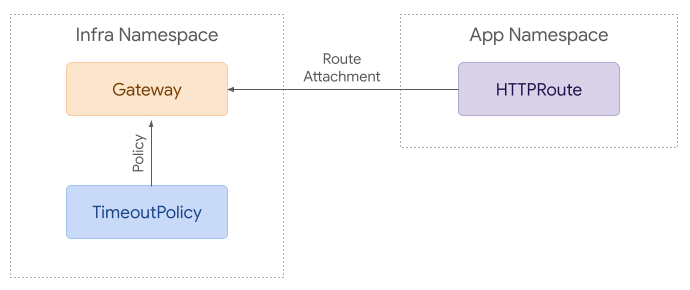Introducing Gateway API v1alpha2¶
October 14, 2021 · 5 min read
We’re pleased to announce the release of v1alpha2, our second alpha API version. This release includes some major changes and improvements. This post will cover the highlights.
Highlights¶
New API Group¶
To recognize our status as an official Kubernetes API, we've transitioned from
an experimental API group (networking.x-k8s.io) to the new
gateway.networking.k8s.io API group. This means that, as far as the apiserver
is concerned, this version is wholly distinct from v1alpha1, and automatic
conversion is not possible.

Simpler Route-Gateway Binding¶
In v1alpha1 we provided many ways to connect Gateways and Routes. This was a bit more complicated to understand than we'd like. With v1alpha2, we've focused on simpler attachment mechanism:
- Routes directly reference the Gateway(s) they want to attach to. This is a list, so a Route can attach to more than one Gateway.
- Each Gateway listener can choose to specify the kinds of Routes they support and where they can be. This defaults to Routes that support the specified protocol in the same Namespace as the Gateway.
For example, the following HTTPRoute uses the parentRefs field to attach
itself to the prod-web-gw Gateway.
apiVersion: gateway.networking.k8s.io/v1alpha2
kind: HTTPRoute
metadata:
name: foo
spec:
parentRefs:
- name: prod-web
rules:
- backendRefs:
- name: foo-svc
port: 8080
This is covered in more detail in GEP 724.
Safe Cross Namespace References¶
Experimental Channel
The ReferenceGrant resource described below is currently only included in the
"Experimental" channel of Gateway API. For more information on release
channels, refer to our versioning guide.
It is quite challenging to cross namespace boundaries in a safe manner. With Gateway API, we had several key feature requests that required this capability. Most notably, forwarding traffic to backends in other namespaces and referring to TLS certificates in other namespaces.
To accomplish this, we've introduced a new ReferenceGrant resource that provides a handshake mechanism. By default, references across namespaces are not permitted; creating a reference across a namespace (like a Route referencing a Service in another namespace) must be rejected by implementations. These references can be accepted by creating a ReferenceGrant in the referent (target) namespace, that specifies what Kind is allowed to accept incoming references, and from what namespace and Kind the references may be.
For example, the following ReferenceGrant would allow HTTPRoutes in the prod namespace to forward traffic to Services wherever this ReferenceGrant was installed:
apiVersion: gateway.networking.k8s.io/v1alpha2
kind: ReferenceGrant
metadata:
name: allow-prod-traffic
spec:
from:
- group: gateway.networking.k8s.io
kind: HTTPRoute
namespace: prod
to:
- group: ""
kind: Service
This is covered in more detail in GEP 709.
Policy Attachment¶
One of the key goals of this API is to provide meaningful and consistent extension points. In v1alpha2, we've introduced a new standard for attaching policies to Gateway API resources.
What is a policy? Well, it's kind of up to the implementations, but the best example to begin with is timeout policy.
Timeout policy for HTTP connections is highly dependent on how the underlying implementation handles policy - it's very difficult to extract commonalities.
This is intended to allow things like:
- Attaching a policy that specifies the default connection timeout for backends to a GatewayClass. All Gateways that are part of that Class will have Routes get that default connection timeout unless they specify differently.
- If a Gateway that's a member of the GatewayClass has a different default attached, then that will beat the GatewayClass (for defaults, more specific object beats less specific object).
- Alternatively, a Policy that mandates that you can't set the client timeout to "no timeout" can be attached to a GatewayClass as an override. An override will always take effect, with less specific beating more specific.
As a simple example, a TimeoutPolicy may be attached to a Gateway. The effects of that policy would cascade down to Routes attached to that policy:

This is covered in more detail in GEP 713.
Next Steps¶
There are a lot of changes in v1alpha2 that we haven't covered here. For the full changelog, refer to our v0.4.0 release notes.
Many of our implementations are planning to release support for the v1alpha2 API in the coming weeks. We'll update our documentation as v1alpha2 implementations become available.
We still have lots more to work on. Some of our next items to discuss include:
- Conformance testing
- Route delegation
- Rewrite support
- L4 Route matching
If these kinds of topics interest you, we'd love to have your input. Refer to our community page to see how you can get involved.